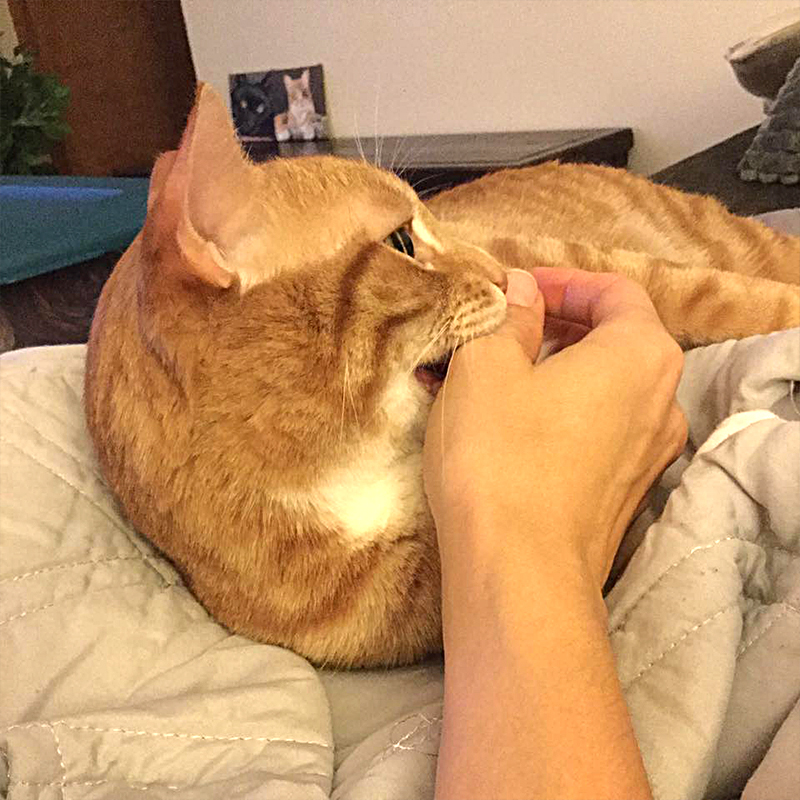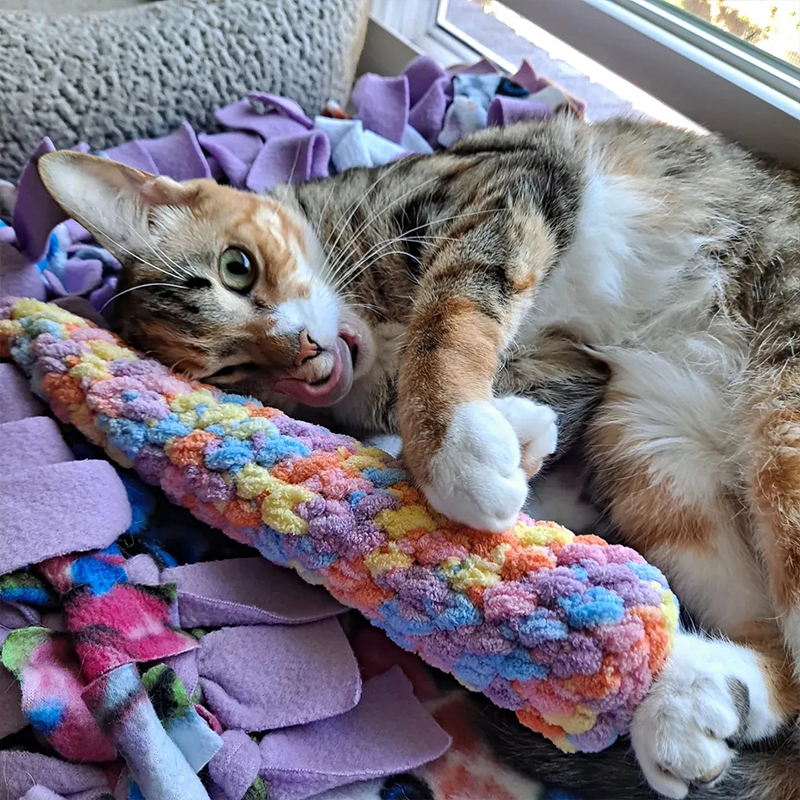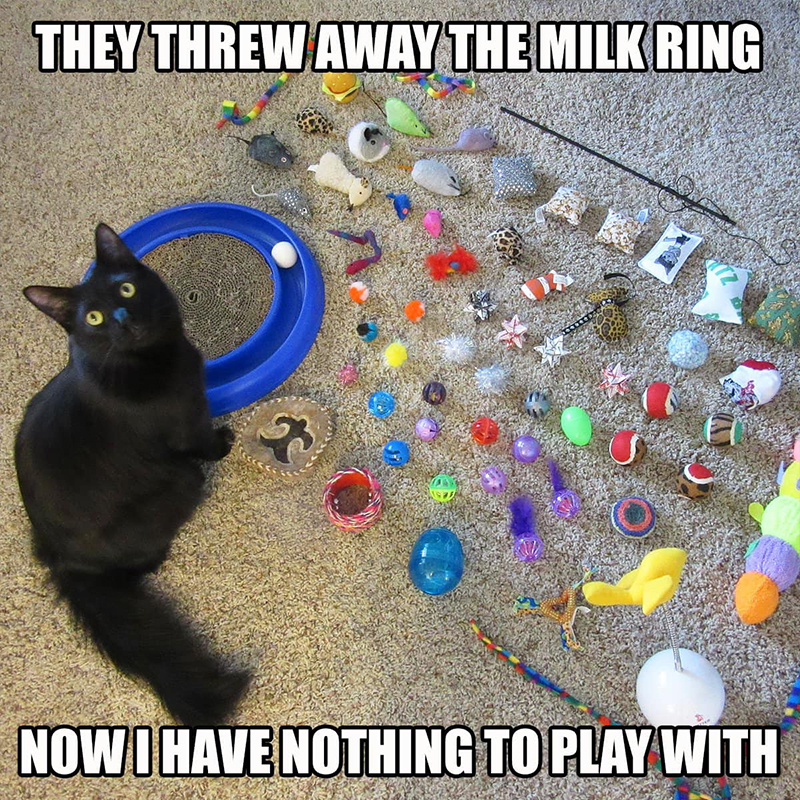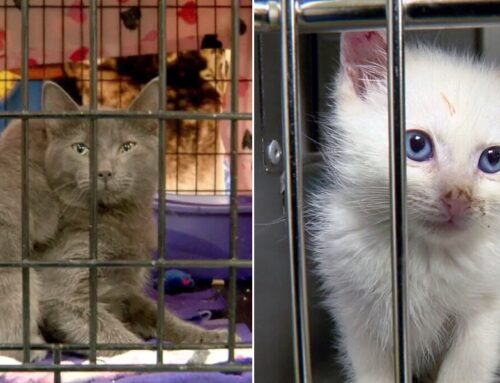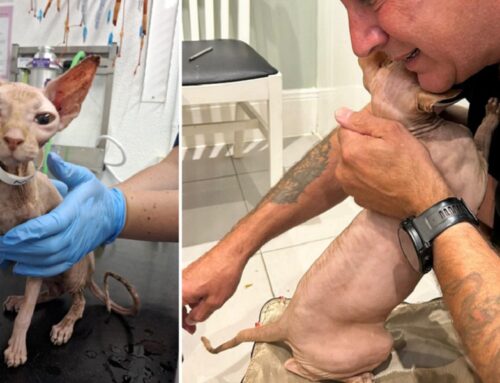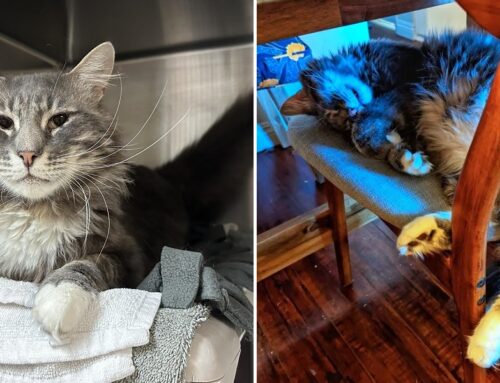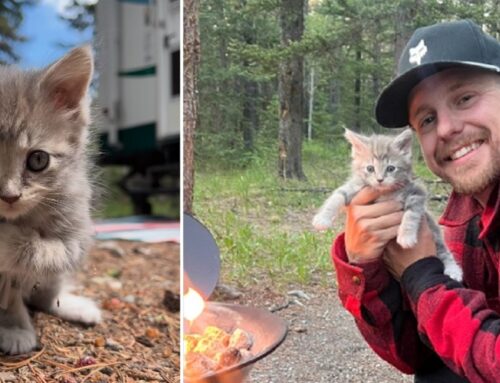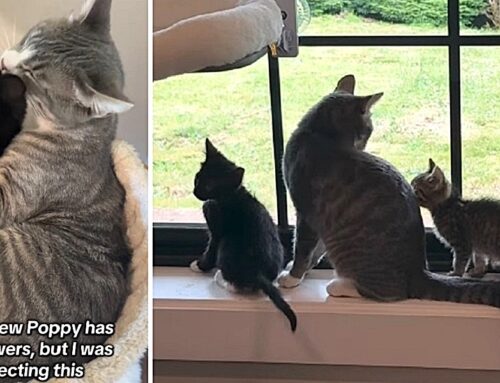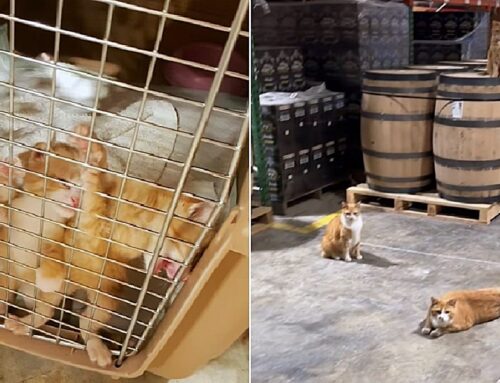Like kids, kittens go through a teething period as they lose their baby teeth and permanent teeth grow in place. While human kids lose their baby teeth around 5 or 6 years old, kittens begin teething around 3 to 4 months old.
The need for baby teeth is the same for humans or cats; their little jaws haven’t yet grown enough to hold a set of adult teeth. That’s why by 8 weeks, kittens grow 26 baby or semi-translucent baby, milk, primary, or deciduous teeth; as you probably know, they can feel like little needles should they bite you.
Eight weeks is generally also when healthy foster kittens are ready to find homes. It’s one more reason to adopt bonded duos: instead of biting your hand, they’ll exert much energy with their best wrestling buddy/sibling. At the same time, they’ll teach each other about healthy boundaries, such as figuring out that biting doesn’t feel very good!
Of course, cats with siblings will also give love bites sometimes.
“Use your words Marmalade….not your little toofers.”
Image via Facebook/Cole and Marmalade
Kitten Teething Can Last Over Four Months
When kittens reach three months old, kitten teething usually begins, starting with the incisors. From there, their permanent adult teeth take 5 to 7 months to fully grow. That’s as many as over four months of teething!
When teething is over, instead of 26 teeth, they have 30 permanent teeth. While cats have molars, they don’t have to worry about wisdom teeth. But, a veterinarian will want to monitor their progress to ensure everything is going smoothly. For example, sometimes, a baby tooth stays in place as the adult tooth attempts to grow under it. That’s why it’s called a persistent baby tooth, and it can prevent the tooth from growing optimally.
While cats very rarely need orthodontics, a vet can help by carefully removing persistent baby teeth. Otherwise, like kids, they can have crowded teeth and an associated risk for periodontal (gum) disease. Cat guardians should be aware that most cats, or 72%, develop a type of cavity called tooth resorptions during their lifetime that must be pulled since these cavities can’t be filled.
During teething, kittens can be uncomfortable, grumpy, and want to chew everything in sight. They may also develop the classic “kitten breath” (gingivitis), have slightly bleeding gums, and drool more. Since their teeth and gums are more sensitive, they may be reluctant to eat. Dry food can be painful to chew, so wet food is especially desirable to help them maintain a healthy weight. As a plus, wet food also has fewer carbs which can be harder for cat’s digestive tracks to digest.
Video by Cole and Marmalade
Brushing Your Cat’s Teeth
At this stage, you can prevent advanced periodontal disease by getting into a routine and brushing your young cat’s teeth with cat toothpaste and a brush designed for cats. Although it’s never easy, introducing brushing early is far easier than doing so for adult cats. Watch the video below for some helpful advice in either case.
“We as cat servants need to do the best we can to help prevent dental disease in our cats,” says Cat Man Chris.
Here’s information on brushing your cat’s teeth by Cole and Marmalade:
Kitten Proofing the Home
During the teething phase, kittens will chew, chew, chew, so be sure to kitten-proof the home. Such things as electrical cords and poisonous houseplants can be quite hazardous. Like dogs, kittens love to chew on shoestrings, and string, in general, is hazardous since cats can easily ingest string.
Many houseplants are toxic and unsafe in homes with cats, but especially with teething kittens. Unfortunately, one of the most dangerous plants is a beautiful lily.
Remember, there is a poison helpline for pets and the Animal Poison Control by the ASPCA if you suspect your cat or dog ate something poisonous. (888) 426-4435. (An incident or consultation fee may apply for either helpline.)

Stock Image via Cole and Marmalade
To ensure safety, the kitten or kittens may need to stay in a designated safe playroom. Whenever possible, supervise playtime, presenting safe toys and then removing them when playtime is over. This prevents them from chewing off something to swallow and also makes them much more excited to see the toys return!
Video by Cole and Marmalade about Common Household Hazards for Cats:
What Kind of Toys Help Teething Kittens?
What kind of toys specifically help teething kittens? These days, there are specially designed bite-resistant teething cat toys to take the guesswork out. Remember that cats shouldn’t chew on string, so remove any toys with string once supervised playtime is over. Always remove anything small enough to be swallowed.
“Calypso had to do some quality control on a unicorn horn!” via Facebook/Cole and Marmalade.
Encourage Teething Kittens’ Healthy Urge to Chew
Teething kittens have a healthy urge to chew, so it’s important to direct their attention to the best options. Since cats naturally like the chew on grass, it’s a great time to introduce safe cat grass (wheatgrass). It’s incredibly easy to grow, and it may help alleviate that chewing urge.
Soft toys for kittens and “kicker toys” help kittens work out frustration and get that adorable bunny kick action going, too! As with teething kids, a cold, wet washcloth (not frozen) can help alleviate tenderness. As always, remove it before any threads become loose so they aren’t swallowed.
Some people swear by raw (never cooked) bones, but there are risks like exposure to bacteria and choking hazards. (Although the risk is far greater with anything cooked). As with anything you have a question about, discuss this option with your vet before trying it.
Again, as with kids, licking iced treats can help soothe teething kittens. Here’s a recipe for frozen treats for cats that also helps during the dog days of summer, too!

Mazikeen with a handmade catnip toy by Jess. Image via Facebook/Cole and Marmalade



